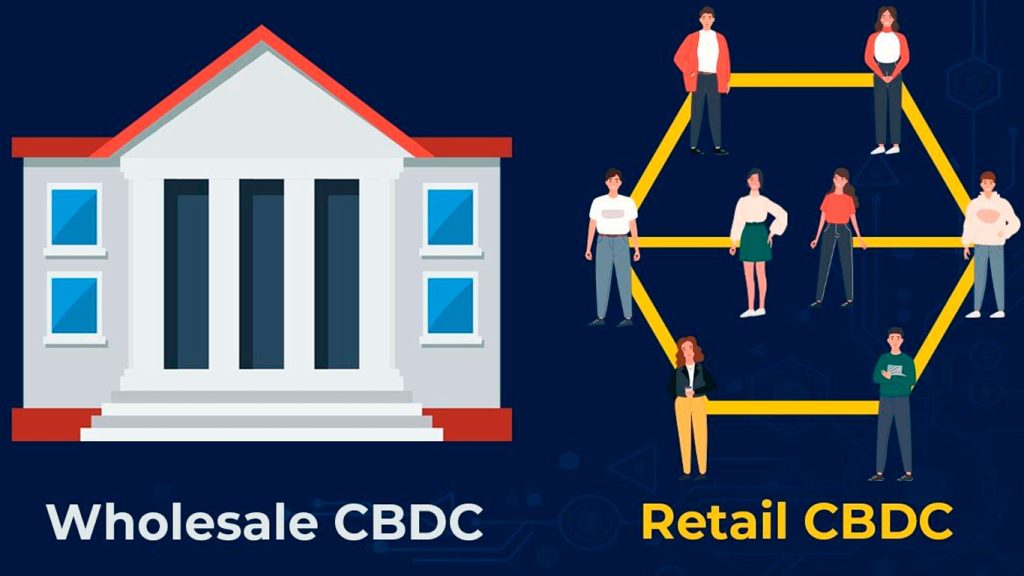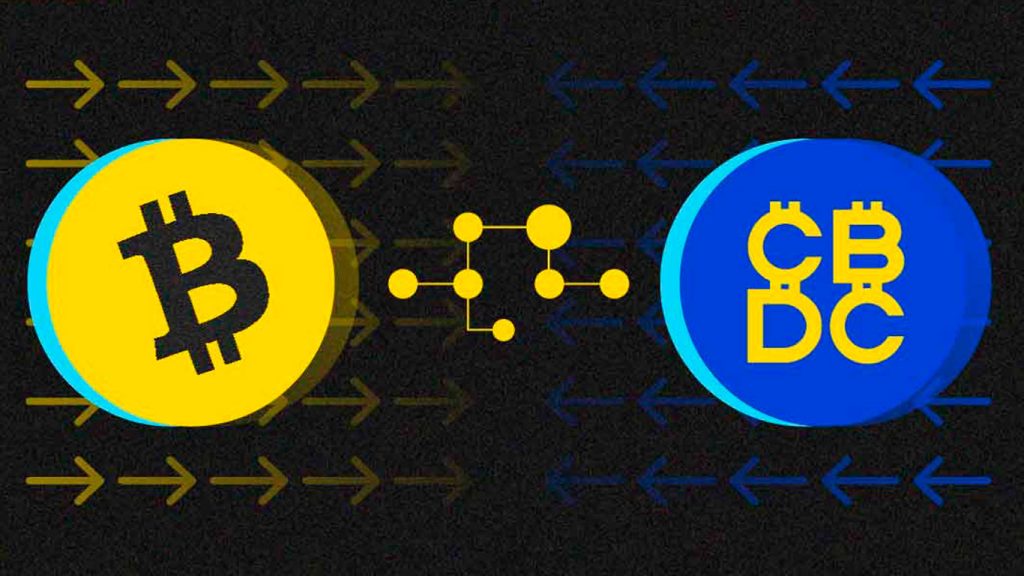Virtual money backed and issued by a central bank is known as a central bank digital currency or CBDC. As digital currencies and stablecoins have gained traction, governments and financial institutions have recognized they need to accommodate digital transactions alongside conventional currency or be left behind.
There are thousands of different cryptocurrencies, or digital currencies, in circulation today. Bitcoin and similar cryptocurrencies are instances of decentralized digital currency.
Because cryptocurrencies are built on distributed ledger technology (DLT), the veracity of a transaction is verified in real time by a decentralized network of computers as opposed to a centralized server.
Payments between banks, organizations, and people are expedited and secured because CBDC is controlled on a digital ledger (which may or may not be a blockchain).
One of the biggest game-changing developments in the world’s financial system right now is the introduction of digital currencies issued by central banks. There have been a lot of uncertainties in the business community over the Crypto vs. CBDC debate. Let’s examine the many ideas behind CBDCs and draw parallels between cryptocurrencies and digital currencies issued by governments.
CBDCs, and Their Various Forms
Payment, clearing, and settlement systems may benefit from the creation of a CBDC, either a general-purpose or wholesale only one.
General-Purpose CBDCs
In this context, “general-purpose CBDC” is a CBDC intended for widespread use. Privacy, transparency, and accessibility are its main advantages. Among the benefits of DLT-based retail CBDC is its availability around-the-clock, every day of the year.
The goal to promote financial inclusion by speeding up the transition to a paperless society, reducing currency production and handling expenses, and taking the lead in the rapidly expanding fintech sector are all driving this trend.

Wholesale Only CBDCs
Reserve deposit-keeping financial institutions are the target market for a wholesale CBDC. One possible use is to lessen the potential for losses due to insufficient funds or other factors affecting the financial stability of a business’s counterparties, hence improving the efficiency of payment and securities settlements.
A value-based wholesale CBDC would replace or complement central bank reserves with an encrypted digital token. In a token-based system, the value is transferred directly from the issuer to the holder of the token, eliminating the need for any third parties.
If the central bank really moved money instead of just debiting and crediting accounts, it would be a major change from the existing system. The wholesale CBDC is the preferred idea among central banks because of its ability to enhance current wholesale financial systems swiftly, cheaply, and securely.
What States Have a CBDC?
Before COVID-19, central bank digital currencies were mostly only a thought experiment. Central banks quickly recognized that they couldn’t afford to lose out on the development of money in light of the necessity to provide massive monetary and fiscal stimulus throughout the globe and the growth of cryptocurrencies.
More than 90 nations (representing over 90% of global GDP) explored joining a CBDC, as reported by the Atlantic Council. In May 2020, just 35 states were actively investigating the possibility of a CBDC.
China has gotten ahead of the game by allowing international tourists to use digital yuan to transmit passport information to the People’s Bank of China for the Winter Olympics. When compared to the European Central Bank, the Bank of Japan, and the Bank of England, the Federal Reserve of the United States lags far behind.
Five countries have now completed the rollout of a digital currency. Historically speaking, the Bahamian Sand Dollar was the first commercially accessible CBDC. The entire rollout of CBDCs is now being tested (i.e., at the pilot stage) in fourteen countries, including significant economies such as Sweden and South Korea.

Crypto vs. CBDC
It’s easy to get central bank digital currencies mixed up with other cryptocurrencies. As we’ve already said, the central bank is the hub of the financial system in central bank digital currencies. Contrarily, cryptocurrencies like Bitcoin are digital tokens generated using cryptographic processes by a decentralized network, sometimes known as a blockchain.
Different from the permissioned (private) blockchains used by CBDCs, permissionless (public) blockchains are used by cryptocurrencies. If the blockchain is open to the public, anybody may join and contribute to the core functions of the network. Public blockchains are able to maintain their decentralized character because anybody can see, edit, and verify transactions taking place on the network. However, a private blockchain is not decentralized and instead acts as a closed, secure database built on cryptographic principles.
A centralized authority determines the limits of CBDC networks. In crypto networks, users collectively have the power to make decisions via consensus.
That’s why CBDCs are centralized and cryptocurrencies aren’t. Furthermore, cryptocurrencies provide privacy, whereas CBDCs open the door for central banks to track asset ownership. Instead of using blockchain for its foundation, as is common with cryptocurrencies, CBDCs are more likely to operate on their own dedicated technical infrastructure.
Moreover, CBDCs are not stablecoins, which are monetary units tethered to a fiat currency such as the U.S. dollar. It’s important to note that a CBDC wouldn’t be “pegged” to anything; it would simply be the fiat currency. If you were to compare a CBDC $1 note to a regular dollar bill, you wouldn’t be able to tell the difference.
CBDCs are restricted for use as a means of payment only and are not to be held in reserve or utilized for speculation. Cryptocurrencies, however, have practical use in both commercial and speculative contexts.
CBDCs would place less emphasis on protecting user information than cryptocurrencies. The crypto industry is undeniably decentralized and operates on a peer-to-peer model, whereas central banks are bound by a number of regulations.
Since cryptocurrency transactions occur directly between users, they may decide what information to provide and how much. The opposite is true with CBDC transactions since massive volumes of data will be sent automatically to tax and regulatory authorities.
Benefits and Drawbacks of Digital Currencies Backed by Governments
Benefits are numerous, and here are the main advantages of CBDC to consider.
CBDCs streamline the execution of monetary policy and other government operations, which is a major pro. Wholesale CBDCs are used to automate the steps required to establish a connection between a client and a central bank, bypassing the intermediary banks. These digital currencies may streamline administrative operations for other government functions like the doling out of benefits and the computation and collection of taxes.
Transferring funds involves middlemen, who might add unanticipated delays or even fraud to the deal. What happens if a bank run happens because of anything like a rumor or an outside event like a financial crisis? The stability of a monetary system may be jeopardized by such occurrences. The risk of a CBDC is reduced since the central bank is accountable for any risks.
CBDC systems allow for the fine-tuning of privacy parameters. In a retail setting, a CBDC with monetary value functions similarly to cash while maintaining users’ privacy via transactional anonymity. On the other hand, CBDCs are accessible through accounts, function like regular bank accounts, and may provide privacy safeguards.
Since CBDCs are digitally recorded and can be monitored without serial numbers, they may be used to discourage criminal activity. By adopting cryptography and a public ledger, a central bank may readily track money across its territory, preventing criminal activity and unlawful CBDC transactions.
One of the obstacles to financial inclusion for large sectors of the unbanked population, especially in developing countries, is the cost of constructing the banking infrastructure required to provide them with access to the financial system. Without investing in expensive infrastructure, CBDCs may facilitate communication between clients and central banks.
Cons are also essential when it comes to substitution of the central bank’s currency.
CBDCs aren’t always the best solution to deal with centralized issues. A centralized body is still to be given the power to carry out financial transactions (i.e., the central bank). As a consequence, it continues to have an impact on citizen-bank communication and financial data.
Users will have to give up some anonymity since the administrator is in charge of accumulating and transmitting digital identifiers. The service provider would be able to see each and every transaction. As with the largest IT companies and ISPs, it might result in privacy problems. Criminals might compromise systems and abuse data, and governments or banks could block transactions between individuals.
Financial transactions spanning many countries and currencies may be facilitated via CBDCs around the clock, regardless of local business hours or holidays. However, international transactions are hampered by the existence of different legal and regulatory frameworks. Combining these models would be difficult.
Unintended repercussions on currency markets from CBDCs cannot be ruled out. If the digital yuan becomes the dominant payment method in China, international businesses may be compelled to accept it as a means of payment, which might jeopardize the dollar’s status as the world’s reserve currency.






